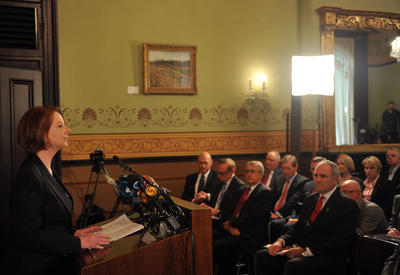The White Paper is a bold, broad-ranging and potentially powerful stimulant for the next phase in Australia’s deepening engagement with its region. The White Paper’s mix of messages and initiatives is about right. The next tests are the strength of government implementation efforts and, even more importantly, the response of the Australian community in the change of mindset it demands.
The Australian White Paper does three things. First, it lays out in irrefutable fashion the magnitude of the change that has already taken place in Asia and the implications of what is to come. This is not just about the transformation of particular countries, or even of the Asian region as a whole — it is about change at the global level that is of historic proportions. The change is so great and so rapid that Australia’s national interests demand adjustment to national behaviour in important ways. There is too much to gain — as well as a great deal to lose — to continue simply with business as usual.
Secondly, it underscores that the primary determinant of Australia’s fortunes is keeping its own economic house in order. Central to this is boosting productivity in ways that can be sustained over the long-term. Economic productivity drives not just the opportunity for lifting living standards but also our ability to reform institutions and advance national interests internationally.
Thirdly — and this is where most of the interest lies — it lays out an array of Asia-specific national preparedness and linkage-building initiatives. The list is impressive, ranging across all sectors of the community — business, government, education and the creative sectors. Among the most important are a push to have one third of board members of publicly listed companies and national government bodies as well as one third of the Australian public service leadership with deep experience in and knowledge of Asia.
In education, there is to be a drive to ensure all Australian school students have substantial exposure to studies of Asia and access to at least one Asian priority language. At the university level there will be increased support to expand the number of students exposed to Asia material in their curriculum, including Asian languages, and expand in-country learning experiences. Schools, technical and vocational institutions, and universities will all be pushed to establish working relationships with counterparts in Asia to increase the two-way flow of ideas.
People-to-people connections will be boosted with 12,000 Australia Awards (over five years) to afford promising individuals precious learning and relationship-building opportunities, including work-placement and mid-career sabbaticals. Work and holiday travel agreements with Asian countries will be expanded.
More broadly, the government has committed to redouble its efforts to bring down barriers to Australia’s economic integration with Asia — at home and in the region — and to expand its diplomatic footprint there, including through strengthening economic and business diplomacy.
Strategic initiatives are part of the game-plan: Australia will push for fairer representation of Asian countries in the key international organisations, support China’s full participation in the region’s development and work with the United States as a continuing and central player in the preservation of regional stability. Relationships with the three big emerging powers — China, India and Indonesia — are signalled as deserving special priority.
These initiatives are highly welcome. The blueprint for change will serve as a national reference point, and signal good intent towards the region. There are smatterings of partisan packaging, but not enough to divert the central thrust.
The question now becomes, what will this government, and its successors, actually do? Most of the key players on both sides of Australian parliament understand very well the importance of the challenge of the Asian Century, an idea that has now become part of the national lexicon.
The test over time will be their preparedness to give these initiatives the priority they will need in order to achieve traction in a fiscally constrained environment. Equally important will be their ability to negotiate the coordination of outcomes with counterparts at the state level. This will be critical for the most important frontier of all: Australian schooling systems are importantly a matter of state level control.
Australia’s ability to rise to the opportunities and challenges that Asia’s transformation has created depends on the choices and actions of society as a whole. Political leaders can map out directions, coordinate policy resources and provide incentives. But it is the decisions of business leaders in firms large and small, education leaders in schools, technical institutions and universities, the leaders of media organisations, community leaders, and arts and cultural institutions that will determine the pace and effectiveness of change.
Australia has been deepening its engagement with Asia for at least 50 years. Geography dictates it. The linkages stretch back to the original human settlement of our landmass. But geography does not determine how successfully we will manage this.
The White Paper provides a good roadmap, and one that will doubtless evolve in the years ahead. We tend to think of Asian countries as being dynamic, creative and adaptable. But Australia is too. With focused effort, there is every reason to believe that Australia is entirely capable of making its distinctive contribution to the Asian Century and being an integral part in the great Asian transformation.
Andrew MacIntyre is Dean of the College of Asia and the Pacific at the Australian National University.

